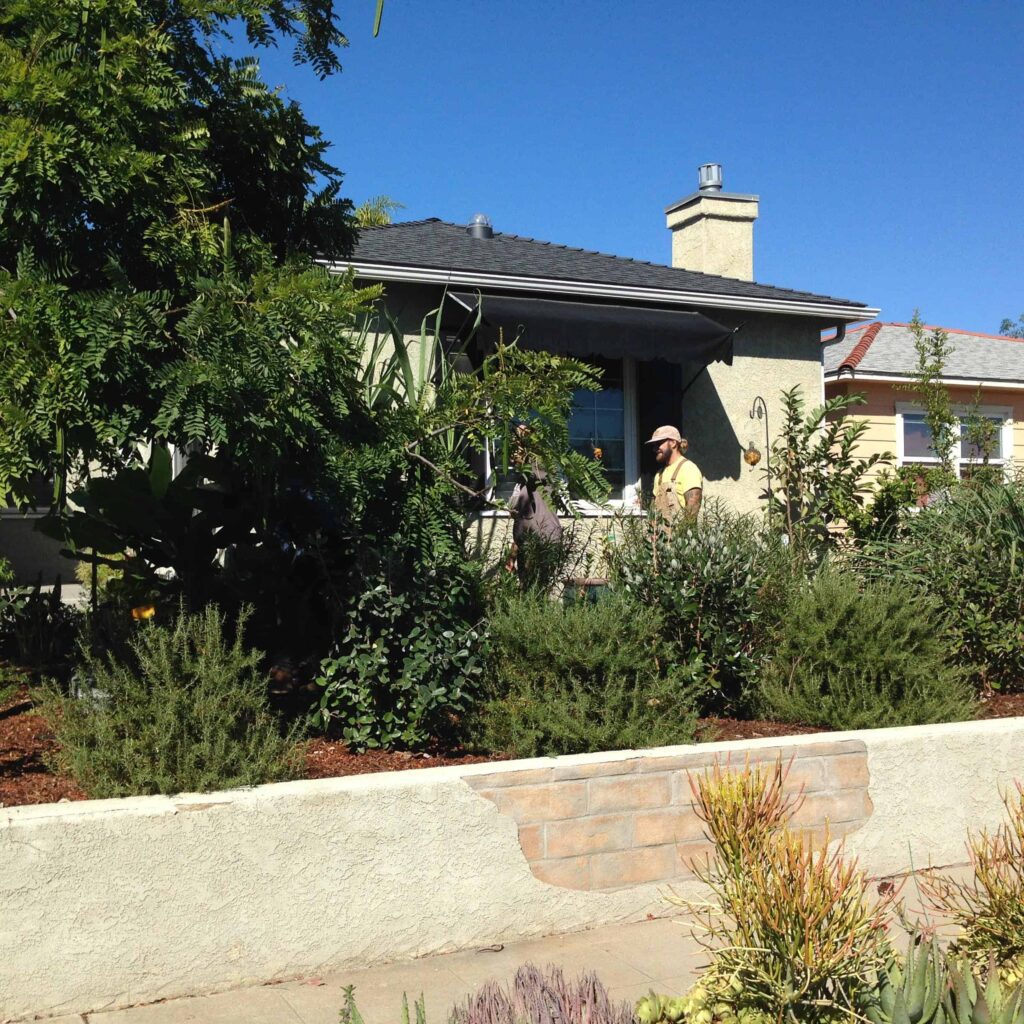Guest Author is Brook Sarson, H2OME
True Water Conservation requires an integrated approach and taking the initiative to be part of the solution. Jo Ann and Ted, in Talmadge, were reluctant to get rid of their front lawn because they did not know what it could turn into, did not want to put something in that required a lot of water and did not like the cactus and gravel look. But, we found a solution that worked.
We arrived at a design including fruit trees, natives and pollinating plants. We installed a 420-gallon rainwater tank that overflows into a basin in the front yard for passive water collection during the rainy season. We put in a simple Laundry-to-Landscape system to provide a consistent supply of water to fruit trees every week. This yard is augmented by good soil and mulch to create better absorption of water and prevent evaporation. In just a year, Jo Ann and Ted have a thriving oasis and more wildlife than ever before (lizards, butterflies, hummingbirds, bees). They have told me that they are amused to overhear their neighbors remark, “Don’t they know we are in a drought?” even as they watch their apples ripen without any municipal water.


Generally, with the right combination of strategies, people are seeing reductions by half in their water use. Here are some tips to help you get started at your own home.
- Start by REDUCING your water use.
Get rid of your thirsty landscape so you don’t need water in the first place. This doesn’t mean artificial turf, gravel and cactus, or hardscaping. It also doesn’t mean investing a ton of money in re-landscaping, tanks, or greywater plumbing. Property value can be preserved with the right plants in the right places and some well directed rainwater. Notice a return of butterflies, hummingbirds, and bees to our neighborhoods! - PLANT THE WATER FIRST.
If you are preparing your landscape for redevelopment and you want to make the best use of your water resources, before you decided on plants and a design, figure out what greywater and rainwater potential you have. Create a water budget. Design your plantings to use the the easiest water to access and at the volumes that are plant appropriate. - GET CREATIVE.
Sometimes, if you can imagine changing some personal habits a little or altering your routines, your water distribution will be more effective! Like changing your shower from a 2GPM shower head to a 1.5GPM shower head. With 20 minutes of showering a day you end up saving 10 gallons a day! That’s 3600 gallons for the year! Not to mention getting the water budget right for your landscape. 40 gallons a day might be too much for a drought tolerant landscape. Better yet, create an outdoor shower to avoid expensive retrofits and let the water go directly to the plants that need them, ending your need for irrigation. - USE SMALL SPACES FOR BIG IMPACT.
This can look like many things, but often looks like a 205-gallon tank instead of a 55-gallon barrel. Did you know that a 1000-square-foot roof will shed 600 gallons in just one inch of rain? With 10 inches of rain on average in San Diego, that adds up to a lot of water. Think big for your water storage needs. - GET THE COMMUNITY INVOLVED.
Getting your neighbors and friends involved can make short work out of a greywater or rainwater installation. Host a workshop for your friends and neighbors. - DO MUCH OF THE WORK YOURSELF.
You just have to learn what your resources are, and make sure you get it done right! Connect with a local expert for a consultation, take their recommendations, and use them as your resource along the way. Buy a good book and follow the instructions. Learn about water budgeting. Take a class and make a friend to skill-share with to get the job done. You can find tons of good resources at www.h2o-me.com. - LOVE THY NEIGHBOR.
Sometimes your neighbors don’t want to do what you are doing, but you’d be surprised how they can contribute if you just ask! Like one family who is borrowing their neighbor’s downspout to help fill their 1320 gallon rainwater tank. - COOPERATION IS THE KEY TO ABUNDANCE.
In our community we have some amazing resources. You don’t have to do everything yourself, and often times we all benefit from working together. Bring a friend to a workshop so you each can internalize the parts of the information that you are best at. Get consultations from local experts in creating a water plan, developing a landscape plan, creating good soil, growing food, growing natives. Likely, if we all rely on people who are really skilled at what they do, we can create something far more abundant than if we try to do everything ourselves. - GROW FOOD.
Did you know that your water footprint takes into account the food you eat? If your food is grown outside of San Diego, your water footprint is higher. Growing food in your own backyard with onsite water (rainwater for veggies, and greywater for fruit trees) means that you aren’t wasting oil to bring the food to San Diego and water, usually imported, to grow your food. - We are ALL part of the solution to creating local water in San Diego.
If all homeowners in San Diego reduced landscape irrigation by 50% using an integrated approach to onsite water management, we would decrease our imported water needs by 20%, more than twice what the Carlsbad desalination provides for our county by much more energy intensive methods! Plus by rerouting our rainwater into our gardens, we offset storm drain pollution and by rerouting our greywater into our soil, we offset costly infrastructure upgrades to wastewater treatment facilities! If you don’t own your home, talk to your landlord, or your friends who own their homes. Turn the conversation up and the water use down! Join the movement.













